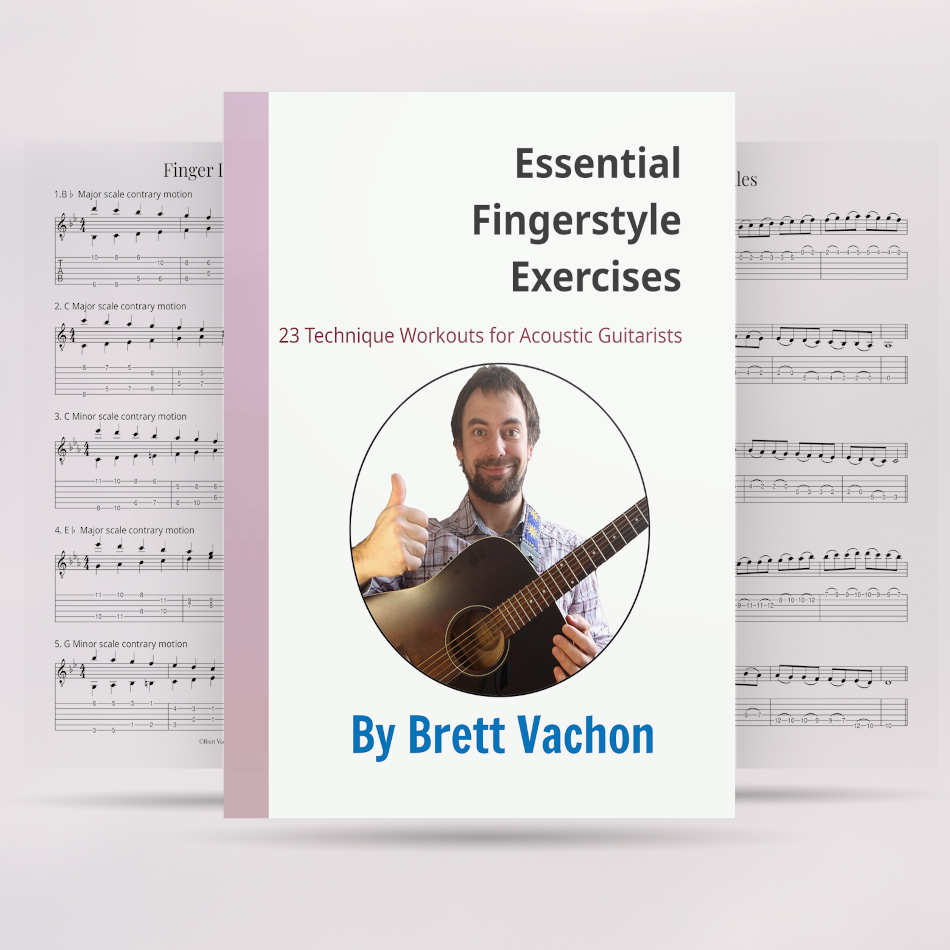Here are 9 arpeggio patterns that you can practice to improve your fingerstyle technique.
As fingerstyle guitarists, it's much easier for us to perform arpeggio patterns than it is for flatpickers. Nevertheless, it's still easy for us to have arpeggios that sound sloppy, due to improper technique.
For instance, I often notice that if I play an arpeggio without paying attention to my finger movements, I find sometimes that I fail to properly pluck the string and have the note ring true.
It's therefore a good idea to have some exercises that you can practice your arpeggios and concentrate on your plucking hand. Here are some that will help you achieve this.
9 Awesome Arpeggios To Practice Your Finger Picking Technique
Here are 9 arpeggio patterns I came up with to practice fingerpicking. Each pattern lasts for 2 measures, and you can repeat them as often as you like.
Remember to simplify the fretting hand as much as possible, as the point is to work on the plucking hand.
Let's get started with something super straightforward that only uses the open strings.
1. Open Warmup
To get your plucking hand nicely limbered up, start with this pattern. It's deceptively simple, but make sure you are using a different finger to pluck the second string open.

2. Bass Break (Minor Version)
Let's practice this time an arpeggio where you will have to simultaneously pluck the treble and bass strings at the same time. Make sure to keep the hand steady as you do this.

3. Bass Break (Major Version)
The same as the minor version, except in A Major. This time, use different fingers to play the A Major chord, so your index finger doesn't have to switch from the first to the second fret.

4. Carcassi Crossing (Minor Version)
I'm a big fan of the classical guitar studies composed by the Romantic guitarist Matteo Carcassi (1796-1853). The Italian guitarists often relied on these types of arpeggio patterns in their compositions. Here's one you can practice that is similar to one of his études.

5. Carcassi Crossing (Major Version)
Once again, like the bass break major version, you can leave the first finger in the third string first fret as you perform this entire arpeggio.

6. Release and Catch (Minor Version)
A lot of arpeggio patterns involve playing the notes in the order p,i,m,a or a,m,i,p, and this does you a bit of a disservice when you encounter more complex arpeggio patterns. Here's one such pattern that doesn't follow the natural order of the fingers.

7. Release and Catch (Major Version)
If you want more practice doing the previous arpeggio pattern but this time in a major key, here's how you can achieve that.

8. Syncopation Talk
Let's take a break from the neoclassical arpeggios and instead look at this arpeggio, a version of which you'll find in more modern fingerstyle songs. In this arpeggio pattern you can put an accent on the note played with the thumb to give it more emphasis.

9. Italian Alps
One of the most challenging arpeggio patterns I find are those that involve the thumb constantly switching strings. In this arpeggio pattern, you can practice a sweeping movement with the thumb going from the sixth string all the way to the second and back down.

How To Practice Arpeggios
To practice arpeggios, start by playing the individual notes of a chord, starting with the lowest note and working your way up to the highest note. Then, try playing the notes in descending order, starting with the highest note and working your way down to the lowest.
Next you can practice playing one measure or four beats of the arpeggio. Once the measure is completed, move the hand up two frets and continue the same picking pattern. You must coordinate your movements for this to sound smooth.
You can start by playing arpeggios while holding a single chord with the left hand. Then you can progress to playing arpeggios while changing chords with the left hand. This is more challenging as it requires coordination between both hands.
With Play Fingerstyle Guitar Now!, you'll gain the tools and knowledge necessary to evolve your fingerstyle technique, breaking through any limitations that have held you back from reaching your full potential.



